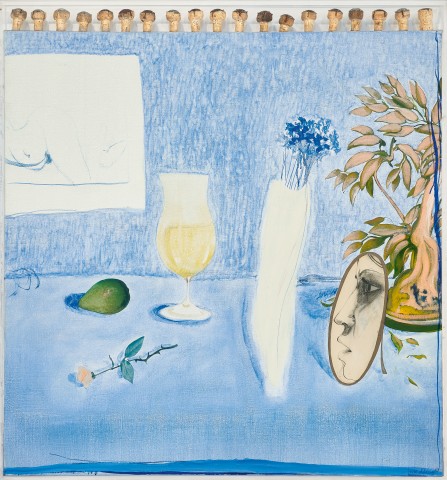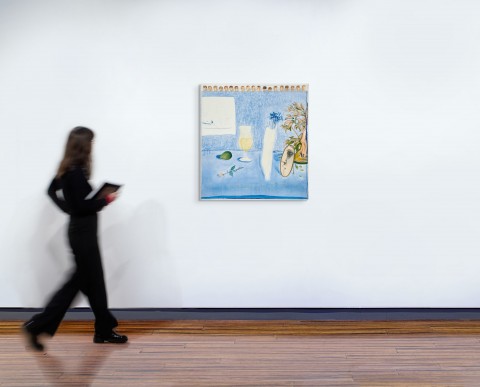(1939 - 1992)
Brett Whiteley
Champagne, 1976
oil and collage on canvas with 19 corks
Australian Galleries, Melbourne (label attached verso, AG3478)
Private collection, Melbourne, acquired from the above in September 1976
Recent Interiors, Still Lifes, Windowscapes, Sculptures and Ceramics, Australian Galleries, Melbourne, 21 September – 5 October 1976, cat. 10
McGrath, S., Brett Whiteley, Bay Books, Sydney, 1979, cat. 44, p. 223 (illus.)
Sutherland, K., Brett Whiteley: Catalogue Raisonné, Schwartz Publishing, Melbourne, 2020, cat. 233.76, vol. 7, p. 386
In the mid-1970s, the Whiteleys’ newly purchased and renovated house in Lavender Bay on the foreshores of Sydney Harbour became the central locus of their lives. Beyond providing for the couple a stable and secluded sanctuary from the world, for the artist it became the wellspring of three new subjects: interior scenes, landscapes viewed through windows, and table-top still life arrangements, each resulting in some of the most beautiful works of his prolific career. A contemplative counterbalance to Brett Whiteley’s previous political and philosophical angst, these new works exuded a sense of luxuriant tranquillity, a fresh return to the basics of art. Considered the crowning achievements of his career, these paintings, ‘where romanticism and optimism overshadow any form of menace or foreboding’, marked a new phase of maturity in the artist’s career.1 Having evolved from the enfant terrible, the Boy Wonder of Australian art, the older, urbane Brett Whiteley found new depths of self-expression in his immediate surroundings, searching for an art of purity, of harmonious pictorial construction and intense optical refinement.
Distilled to the point of serene simplicity, Whiteley’s still life painting Champagne, 1976, is directly descended from the artist’s multifaceted Matissean interiors, prize-winning works also produced during this year of extraordinary artistic achievement. Crowned by a row of celebratory champagne corks giving the work its title, the painting presents a tabletop arrangement of the evanescent, finer things in life: a freshly poured flute of French champagne (with minuscule bubbles escaping from its rim), a cut rose, a bouquet of cornflowers in a ceramic vase made by a friend, fresh fruit, a growing bonsai tree, the reflection of a lover and her painted silhouette pinned to the wall.2 With close focus and shallow pictorial depth, the assorted objects are each painted with a different touch, presenting a medley of Whiteley’s artistic expertise and an array of his most persistent motifs casually combined in this intimate and airy composition.
In 1975, the artist travelled once again to New York to present an exhibition of drawings, including views from Lavender Bay, at the esteemed Marlborough Galleries. While he had been pleased to find a favourable reception to right the wrongs of his earlier American disappointment, the temptations of New York’s underbelly once again reinforced his dependence on narcotics.3 Returning home to Lavender Bay, throughout 1976, Whiteley’s life became increasingly secluded, narrowed to include only Wendy and his closest friends. The concentrated intensity of this focus generated two important boons to Whiteley’s art: an intensification of the relationship with his muse, Wendy, and a new approach to colour, as the light reflected off the harbour bounced through the windows onto the white-washed walls of his living room – the artistic centre of his universe at the time. From colour flowed the lyrical intensity of Whiteley’s Lavender Bay interiors and still life paintings: ‘colour, hitherto largely ignored or downplayed, has this time been used in saturation’, he explained.4
Exemplifying the extreme chromatic richness of this saturation is Whiteley’s contemporaneous, Archibald-prize-winning painting from 1976, Self-portrait in the studio (Art Gallery of New South Wales) – perhaps his most famous work. It displayed the ‘ecstasy-like’ effect of stinging ultramarine blue, which Whiteley observed, ‘…hit my nervous system in such an exciting way.’5 His still lifes similarly prioritised a limited chromatic palette, from the symphony of creams of Still life with peewee’s egg, 1976 (private collection) to the resonant expanse of ‘Brahmsian plum’ in Still life without lemon, 1976 (private collection). Evoking an atmosphere of lightness, Whiteley’s signature blue hue is applied in thin, diaphanous layers, in a large interior, My armchair, 1976, and again throughout this still life, Champagne. Combined with striking areas of white, the reduced colour palette referenced Whiteley’s enduring love of Chinese art. In the centre of the composition, painted with a greater concentration of ultramarine pigment set against a slender white vase, is a bouquet of cornflowers. Included in several still life compositions of this time, the motif of the blue cornflower, perhaps through a poetry of association with her distinctive eye colour, symbolised Wendy’s presence.6
‘All my work has been hinged to her, is drawn formally and aesthetically from her. She is an inexorable part of my creative process’, Whiteley rhapsodised about his wife and her influence in his art.7 While in Self-portrait in the studio, Whiteley inserted his own reflection into the scene by the aid of a mirror, here, in Champagne, it is Wendy’s profile that is painted into the oval frame. She appears again as the subject of an ink sketch, loosely painted and hung on the wall, cropped by the right-hand side of the painting. Injecting a physical sensuality into this still life, the nude adopts the same reclining pose as the figure in the foreground of Self-portrait in the studio. Self-referentially painting his artworks into interior and still life compositions allowed Whiteley to virtually invite the viewer into his private sphere. Painted around the same time as Champagne, Self-portrait in the studio and Interior with time past (winning the 1976 Archibald and Sulman Prizes respectively, a rare feat), with their immersive display of artworks-within-artworks, make explicit reference to the work of French post-impressionist Henri Matisse’s Red studio, 1911 (Museum of Modern Art, New York). Indeed, it was Matisse’s famous dream of ‘an art of balance, of purity and serenity, devoid of troubling or depressing subject matter’8, which provided a touchstone for Whiteley’s mature works.
Displaying objects evoking the passage of time in the manner of an allegorical vanitas still life painting, in Champagne, Whiteley acknowledges the tradition of the artists who preceded him without losing his unique visual voice. In Champagne, the artist emphasises the flat artifice of painting and the fabricated nature of this arrangement. He toys with the real and the artificial in his still life compositions, including photographic collage elements or even physical objects such as oyster shells glued onto the canvas, and arranging them according to what he described as a ‘chess game’ of atmospheric suggestion.9 Painted with an inky fluidity, Whiteley frames the scene with an irregular border, which, like the window frames of his Window series, creates a subtle spatial disorientation to suggest a rich life to be experienced beyond the canvas.
Champagne was one of eight still life paintings exhibited at Brett Whiteley’s solo exhibition at Australian Galleries in October 1976, described as ‘the most brilliant success of his career.’10 Also including My armchair and Interior with time past, the latter before it was submitted to the Sulman Prize, the exhibition was reviewed by Age critic Maureen Gilchrist as ‘a vision of joy’ which ‘captivates and overwhelms the viewer with a tremendous and infectious vitality.’11
1. ‘Artist statement’, Brett Whiteley: Lavender Bay Series, Australian Galleries, Melbourne, November 1974
2. The slender formed vase is likely one thrown by Derek Smith, with whom Whiteley was collaborating at the time, while the bonsai tree recalls Whiteley’s wabi-sabi influenced Bonsai installation at The Yellow House artists’ community in Potts Point in 1971
3. McGrath, S., Brett Whiteley, Bay Books, 1979, pp. 185 – 186
4. Brett Whiteley, ‘Artist Statement’ cited ibid., November 1974
5. Brett Whiteley, cited in interview with Phillip Adams, Radio 2UE, Sydney, September 1986
6. Sutherland, K., Brett Whiteley: Catalogue Raisonné, Schwartz Publishing, Melbourne, 2020, vol. 7, p. 947
7. Brett Whiteley, cited in Wilson, A., Brett Whiteley: Art, Life and the Other Thing, Text Publishing, Melbourne, 2016, p. 246
8. Matisse, H., ‘Notes d'un peintre’, La Grande Revue, Paris, vol. 52, 1908, pp. 731 – 45
9. Brett Whiteley, cited in McGrath, ibid., p. 185
10. McGrath, ibid., p. 186
11. Gilchrist, M., ‘A headlong plunge into a vision of joy’, The Age, Melbourne, 24 September 1976, p. 16
LUCIE REEVES-SMITH

